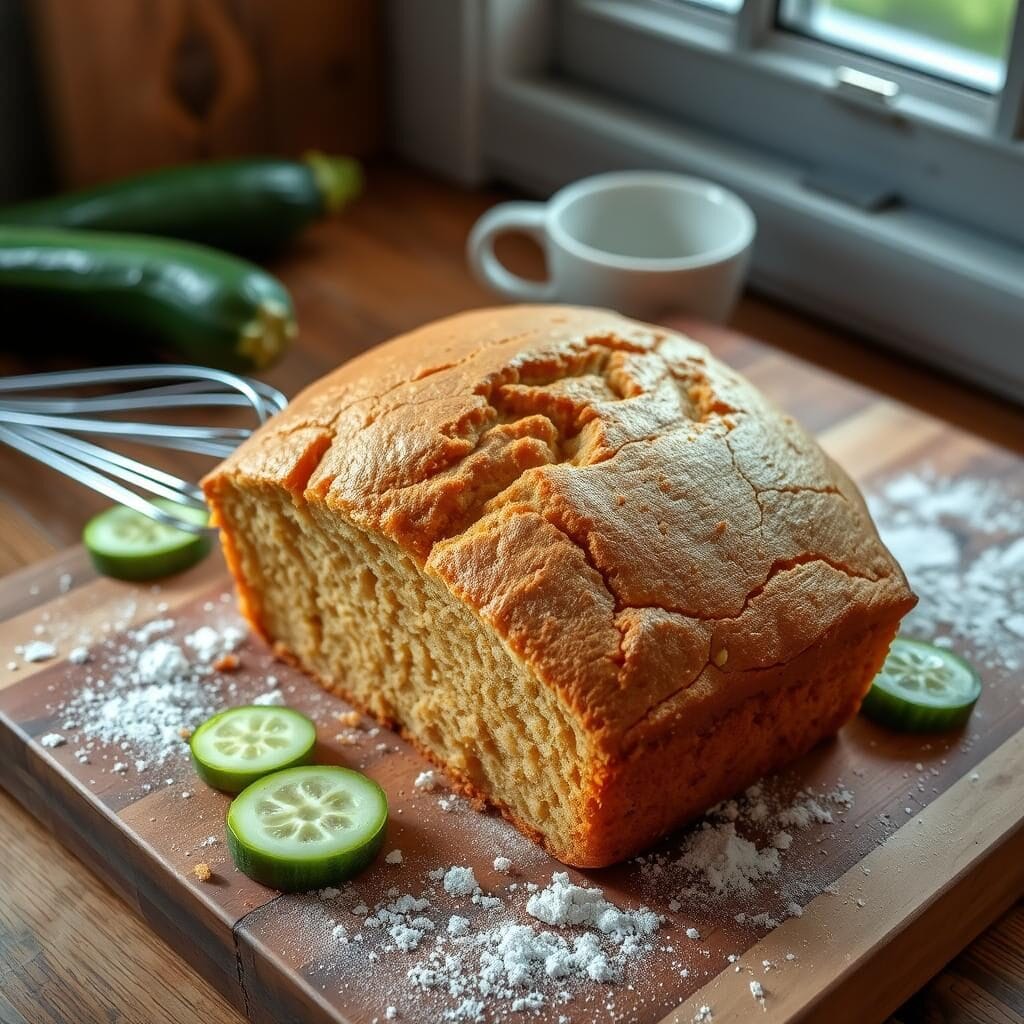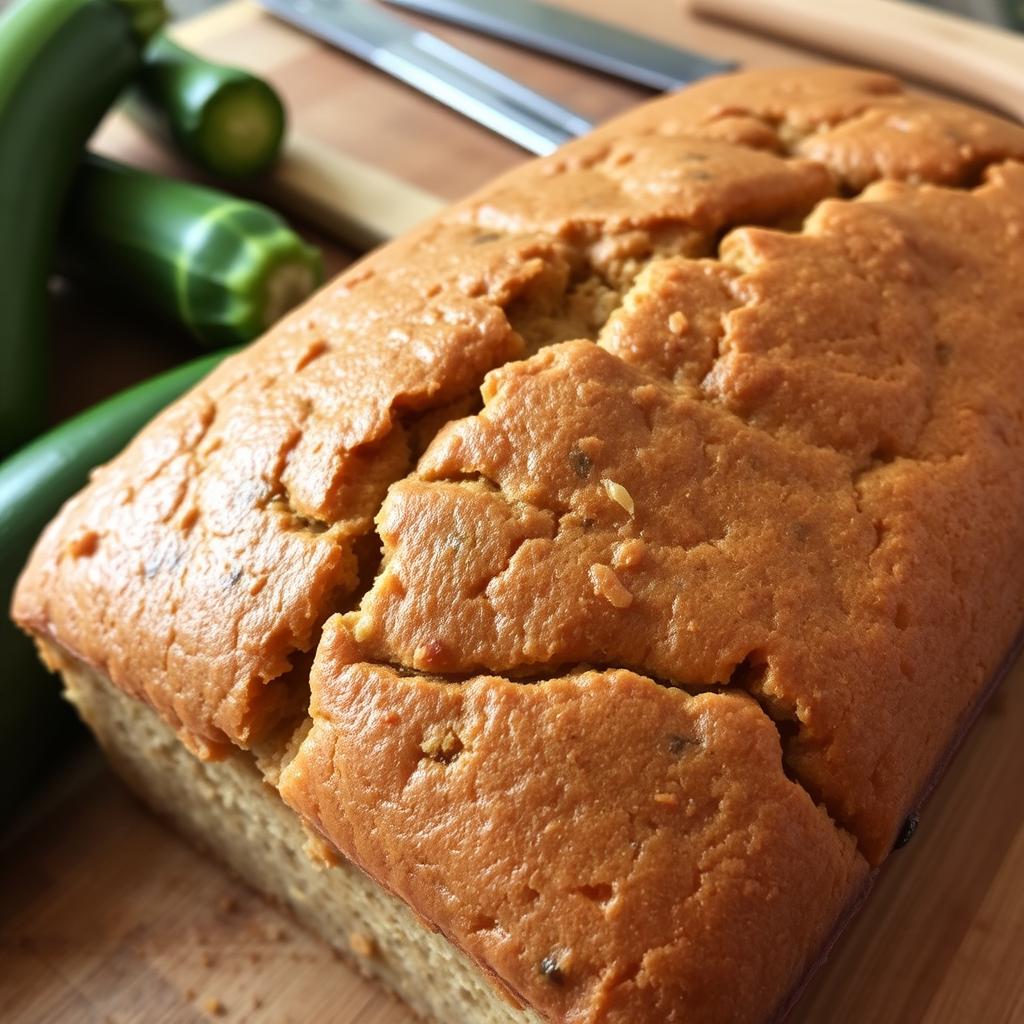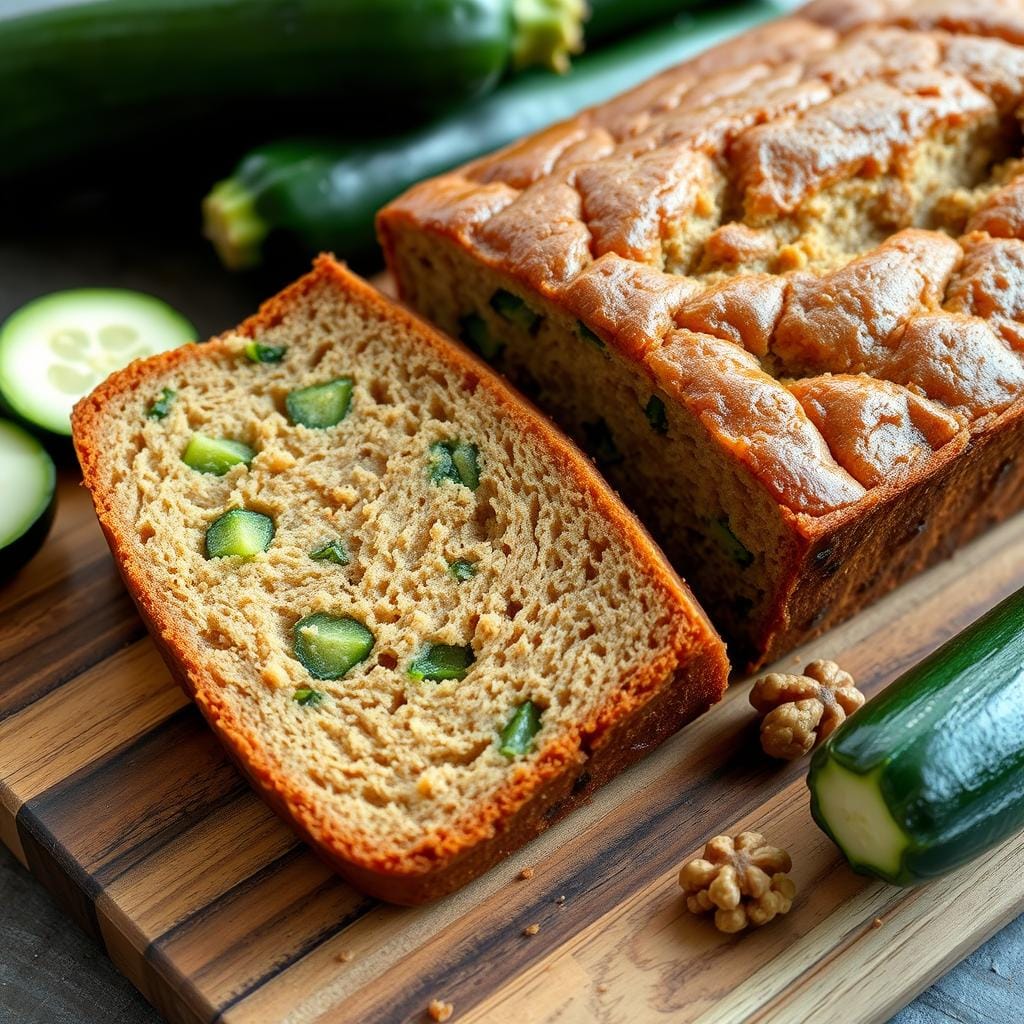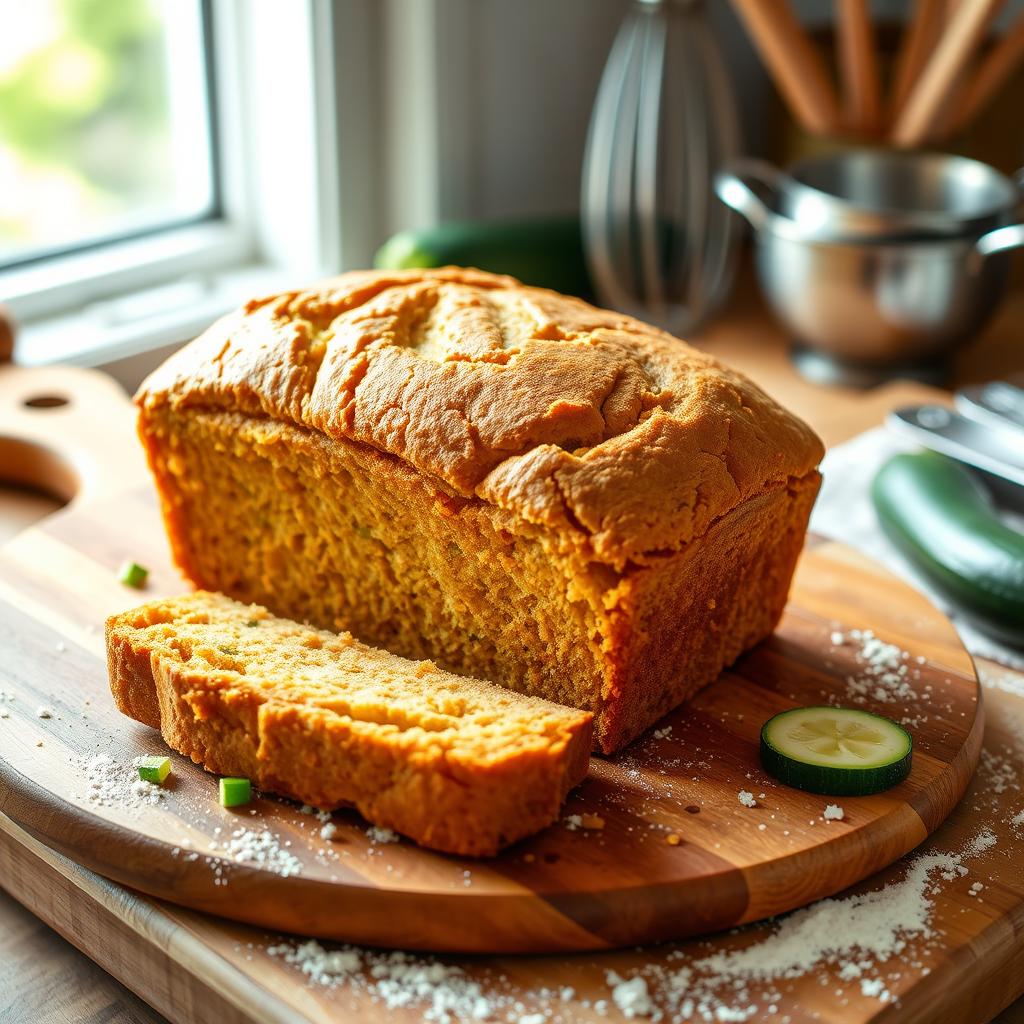Ever pulled a loaf of zucchini bread from the oven, only to find it rubbery and dense? It’s a common problem that can puzzle even the most skilled bakers. But don’t worry, with a few tweaks, you can get the moist, tender crumb you’ve always wanted.
As a dedicated home baker, I know how upsetting it is to spend time on a recipe only to have it not turn out right. That’s why I’m here to share my tips for fixing your zucchini bread. This guide will help both new and experienced bakers master the art of zucchini bread.

Key Takeaways
- Understand the science behind rubbery zucchini bread texture
- Identify and avoid common overmixing mistakes
- Properly prepare and manage the moisture content of your zucchini
- Optimize oven temperature and baking time for the perfect texture
- Choose the right leavening agents and fat content to enhance your bread’s structure
- Troubleshoot your recipe and make adjustments to achieve the desired texture
- Store your zucchini bread properly to maintain its perfect texture
Understanding the Science Behind Rubbery Zucchini Bread
Getting the right texture in zucchini bread is all about balance. Knowing the science behind it can help fix rubbery results. Factors like gluten, moisture, and temperature are key to the bread’s texture.
Gluten Development and Its Effects
Gluten in flour gives baked goods structure and chewiness. But overmixing can make gluten too strong, making the bread rubbery. It’s important to mix just right to avoid this.
Role of Moisture Content
The moisture in your zucchini bread recipe affects its texture. Too much makes it gummy, while too little makes it dry. It’s vital to prepare and drain the zucchini right to get the moisture just right.
Impact of Temperature on Texture
The baking temperature also matters for the bread’s texture. High temperatures can make the crust set too fast, trapping steam and making the inside rubbery. Keeping your oven at the right temperature and watching the bread closely can help it turn out soft and fluffy.

By grasping these scientific principles, you can tweak your mixing, ingredient prep, and baking to avoid rubbery zucchini bread. You’ll get the light, tender crumb you’re after.
Why Did My Zucchini Bread Turn Out Rubbery?
If your zucchini bread feels rubbery, there are a few reasons why. Too much moisture, underbaking, and wrong leavening agents can cause this problem. Let’s look at these issues and find ways to make your zucchini bread soft and fluffy.
Excess Moisture
Zucchini has a lot of water, which can mess up your bread’s texture. Too much moisture stretches the gluten, making the bread rubbery. Make sure to dry your grated zucchini well before mixing it into the batter.
Underbaking
Removing your zucchini bread from the oven too early can make it rubbery. It needs enough time to bake through completely. Use a toothpick to check if it’s done before taking it out of the oven.
Improper Leavening
Using the wrong amount or type of leavening agents can also affect your bread. Make sure to follow the recipe’s instructions for the best results. This will help your bread rise right and stay fluffy.

“Baking is a science, and understanding the role of each ingredient is key to achieving the perfect texture.”
By fixing these common problems, you can make moist, light, and non-rubbery zucchini bread. Keep reading for more tips on mixing, baking, and solving recipe issues for the best results.
The Most Common Overmixing Mistakes to Avoid
Making the perfect zucchini bread can be tricky. Overmixing the batter often leads to a dense, rubbery texture. Learning the right mixing techniques is key to avoiding this problem.
Proper Mixing Techniques
Mixing your zucchini bread batter needs a gentle touch. Fold the ingredients together softly, avoiding overworking the gluten. This helps prevent a tough, rubbery texture.
Signs of Overmixed Batter
- Tough, dense, or rubbery texture in the final loaf
- Visible tunnels or holes running through the bread
- A coarse, uneven crumb structure
- Decreased rise and volume in the baked bread
Tools for Better Mixing Results
For the best zucchini bread, use a light touch and the right tools. A silicone spatula or wooden spoon works well for gentle folding. A stand mixer with a paddle attachment can also help without overmixing.
By knowing what to avoid and mastering mixing, you can make a zucchini bread that’s tender and moist.
Managing Moisture: Preparing Your Zucchini Properly
To get the perfect zucchini bread, start with the right zucchini prep. Too much moisture makes it rubbery, while too little makes it dry. The goal is to find the perfect balance.
First, grate the zucchini with a box grater or food processor. This makes it fine and even, blending well with the batter. But, it also gets rid of a lot of moisture.
To get rid of extra water, wrap the grated zucchini in a towel or cheesecloth. Squeeze it gently to remove as much moisture as you can. Or, put it on a baking sheet with paper towels for 30 minutes. Press down to soak up the moisture.
After removing the extra water, your zucchini is ready for the batter. This step is key to avoiding a rubbery quick bread texture. It ensures your bread is moist and tender.
| Technique | Benefit |
|---|---|
| Grating Zucchini | Achieve a fine, consistent texture that blends seamlessly into the batter |
| Removing Excess Moisture | Prevent a rubbery quick bread texture and ensure the perfect moisture balance |
“Properly preparing the zucchini is a crucial step in achieving the perfect texture for your quick bread.”
Essential Temperature and Timing Guidelines
Baking the perfect zucchini bread needs the right temperature and timing. Knowing the best oven settings, checking for doneness, and cooling properly are key. These steps help achieve a moist and flavorful texture.
Optimal Oven Settings
To avoid a rubbery zucchini bread, make sure your oven is at the correct temperature. The best oven temperature for zucchini bread is between 350°F to 375°F. Wrong oven temperature can cause uneven baking and a bad texture.
Testing for Doneness
Watching the baking time is important. Zucchini bread usually bakes for 50 to 60 minutes, depending on your recipe and oven. Use the toothpick test to check if it’s done – if the toothpick comes out clean, it’s ready.
Cooling Process Impact
Let your zucchini bread cool completely on a wire rack before slicing. Cooling helps set the structure and prevents it from becoming rubbery. Rushing the cooling can make the bread dense and gummy. So, be patient and let it cool fully before enjoying.
Mastering the essential temperature and timing guidelines ensures your zucchini bread is perfectly moist and flavorful every time.
Selecting and Using the Right Leavening Agents
Choosing the right leavening agents is key to baking perfect zucchini bread. Using the wrong ones can make your bread feel rubbery and dense. This can ruin your baking experience. To fix this zucchini bread troubleshooting issue, knowing how these ingredients work is crucial.
Baking soda and baking powder are the main leavening agents in zucchini bread. Baking soda reacts with acidic ingredients like buttermilk to create bubbles. These bubbles make the bread rise. Baking powder, however, works twice: once when mixed and again when heated in the oven.
Getting the right mix of baking soda and baking powder is essential. The wrong mix can make your bread too dense or too light. By carefully measuring and adjusting, you can get your zucchini bread just right.
- Begin with the recipe’s suggested amounts of baking soda and baking powder. Adjust based on your batter’s moisture and other ingredients.
- If your bread feels too dense, try adding a bit more baking powder and less baking soda.
- For overly risen, dry bread, cut down the baking powder and add more baking soda.
Leavening is a delicate science. It might take some tries to get it just right for your zucchini bread. But with patience and attention to detail, you can make your bread light, fluffy, and delicious every time.
“The key to perfect zucchini bread lies in understanding the role and balance of leavening agents. Get it right, and you’ll be rewarded with a soft, tender crumb that’s a joy to savor.”
The Role of Fat Content in Texture Development
Fat content is key to perfecting your zucchini bread’s texture. The type and amount of fat used greatly affect the bread’s mouthfeel and consistency. Knowing how fats influence your bread can help you perfect your recipe and avoid a rubbery texture.
Types of Fats to Use
The fat you choose can significantly change your zucchini bread’s texture. Here are some common fats:
- Butter – Adds a rich, creamy texture and flavor but can make the bread denser if used too much.
- Vegetable oil – Creates a lighter, more tender crumb but might lack the flavor butter provides.
- Olive oil – Adds a subtle, savory taste and helps make the bread moist and tender.
- Coconut oil – Gives a slight coconut flavor and a soft, tender crumb.
Try mixing different fats to find the best balance for your zucchini bread’s quick bread texture issues.
Measuring and Incorporating Fats
Getting the fat measurement right and mixing it in correctly is key for the right texture. Measure fats accurately and avoid over-mixing the batter. This can make the crumb rubbery or dense. Gently fold the fat into the batter without overmixing to prevent too much gluten.
| Fat Type | Recommended Amount (per 1 loaf) |
|---|---|
| Butter | 1/2 to 3/4 cup |
| Vegetable Oil | 1/3 to 1/2 cup |
| Olive Oil | 1/4 to 1/3 cup |
| Coconut Oil | 1/4 to 1/2 cup |
Adjust the fat amount based on your taste and the recipe’s moisture level to get the perfect quick bread texture issues.
Storage Tips to Maintain Perfect Texture
Enjoying the zucchini bread you baked is great. But keeping it perfect over time is a challenge. Follow these key storage tips to keep your zucchini bread troubleshooting on track.
First, let your zucchini bread cool completely before you touch it. This step is crucial to avoid a soggy or rubbery crust. Once it’s cool, wrap it tightly in plastic wrap or foil, making sure there are no air pockets.
To keep it fresh, store the wrapped bread at room temperature. Don’t refrigerate it, as the cold and damp can make it soggy. When you’re ready to eat it, just unwrap and slice.
If you want it softer, store it in an airtight container or bag. This keeps moisture in and the crust from drying out. For a crisper crust, leave it unwrapped on the counter.
Lastly, know the right time to store it. Freshly baked zucchini bread stays good at room temperature for 3-4 days. Frozen slices can last months in an airtight container.
By using these storage tips, your homemade zucchini bread troubleshooting will always yield a perfect loaf. Enjoy every slice, from the first to the last.
Troubleshooting Your Recipe: Ingredient Ratios and Adjustments
Getting the perfect texture in zucchini bread is all about balance. If your loaf feels rubbery, it’s time to check your ingredients. Look at the flour-to-liquid ratio and sugar content to fix your recipe.
Flour-to-Liquid Balance
The right mix of flour and liquid is key for quick bread texture. Too much flour makes it dense, while too little makes it gummy. Check your recipe’s flour-to-liquid ratio. If it’s too thick, add a bit more milk or yogurt until it’s smooth.
Sugar’s Role in Texture
Sugar does more than add sweetness; it helps with texture too. The right amount of sugar makes the bread softer and more tender. If your bread is rubbery, try adding a bit more sugar to balance the moisture.
By adjusting your ingredients and understanding quick bread texture, you can fix your zucchini bread. Make small changes and track your results to find the perfect recipe for your family.
| Ingredient | Effect on Texture |
|---|---|
| Flour | Too much flour can result in a dense, tough crumb |
| Liquid | Too little liquid can lead to a gummy, underbaked interior |
| Sugar | The right amount of sugar helps to tenderize the gluten, creating a softer, more tender crumb |
Conclusion
In this guide, you’ve learned how to make perfect zucchini bread. You now know about gluten, moisture, and temperature. This knowledge helps you fix common problems like a rubbery crumb.
You’ve discovered how to mix ingredients right and prepare zucchini. You also know which leavening agents to use. These tips help your quick bread be moist, tender, and tasty every time.
Remember these tips as you keep baking. They’re great for both new and experienced bakers. They help you solve zucchini bread troubleshooting and quick bread texture issues. Enjoy making and sharing delicious zucchini bread with your loved ones.

